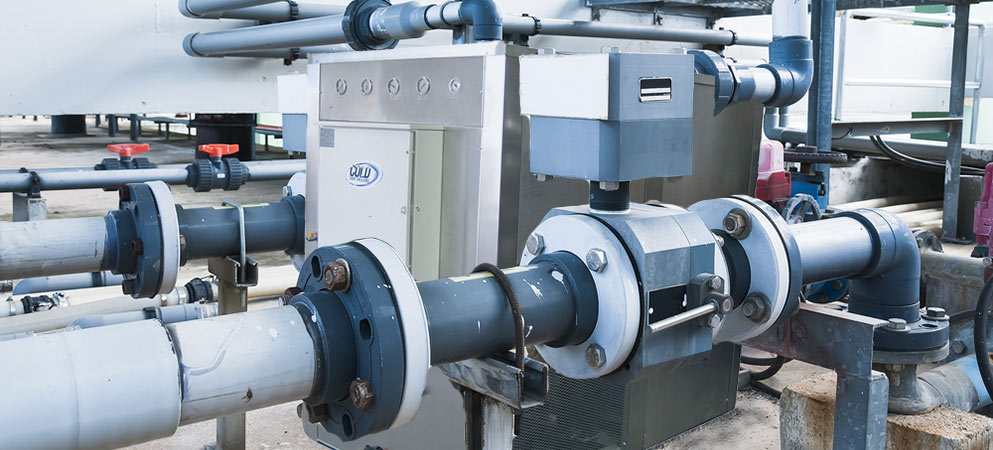
TEMPERATURE CONTROL OF WASTEWATER DURING WATER TREATMENT PROCESS
TEMPERATURE CONTROL OF WASTEWATER DURING WATER TREATMENT PROCESS

Wastewater is an unavoidable by-product of most manufacturing processes. Wastewater generated by industrial activities contains chemical, biological and physical contaminants that can be harmful to both plant and animal life within the affected environments (land and aquatic).
In the US, the environmental protection agency (EPA) regulates the treatment and discharge of wastewater under the Clean Water Act. This requires all industrial operators to adhere to strict treatment protocols. A critical aspect of wastewater treatment is process temperature control.
This article will consider the reasons why cooling in the wastewater treatment process is necessary and outline different methods for controlling supporting process temperatures for wastewater treatment.
Why Do Wastewater Treatments Processes Need to Be Cooled?
Secondary wastewater treatment processes heavily rely on the use of bacteria to eliminate organic matter from sewage. Common methods involve the use of trickling filters, activated sludge, and sodium hypochlorite injection.
In most cases, the bacteria used in water treatment plants function optimally at temperatures between 68°F and 95°F. These microorganisms can still function at a slowed rate with lower temperatures, but significant elevations in thermal conditions can destroy the bacteria and render the process ineffective. Cold Shot Chillers does not typically supply industrial water chillers for this application, but frequently supplies units for hypochlorite electrolysis cooling.
On-site hypochlorite generators use the electrolysis to turn brine water into sodium hypochlorite. Because this chemical reaction produces significant amounts of heat, the produced sodium hypochlorite solution needs cooled before it is sent to dosing points within the wastewater treatment plant.
Considerations for the Temperature Control of Wastewater Treatment Processes
Maintaining appropriate temperatures within a wastewater treatment plant requires operators to use thermoregulatory devices. The most effective cooling water treatment process involves the use of industrial chiller systems to maintain temperatures. Chiller units may come as closed-loop types and may be air-cooled or water-cooled.

Use a Closed-Loop Chiller System
These chiller types are recirculating systems that channel coolant fluid within a series of pipes to achieve cooling. The coolant used in closed-loop chillers is usually water or a mixture of water and glycol.
How Does A Closed Loop Chiller Work?
A closed-loop chiller has the following components:
- A network of sealed pipes
- Coolant
- Storage tank
- Refrigeration unit
- Evaporator
- Heat load/ heat exchanger
- Thermostat
When in operation, a closed-loop chiller functions similarly to a typical refrigerator unit. Coolant within a storage tank is chilled and then channeled through the chillers tubing to reach the heat source.
In the case of a wastewater treatment plant, the secondary treatment unit is connected via a heat exchanger to the chiller system. A preinstalled thermostat keeps a record of the temperatures within the water treatment process and automatically supplies or cuts off the flow of chilled coolant to the process.
After removing unwanted heat from the treatment unit, heat is dissipated from the coolant fluid within an evaporator unit before it is sent back to the refrigeration component of the chiller for cooling and recirculation.
Using a closed-loop chiller to regulate wastewater treatment process temperatures has several benefits including an overall lower operating cost and improved safety due to its enclosed design.
Use an Air-Cooled Chiller
An effective method of achieving wastewater process temperature regulation incorporates the use of an air-cooled chiller unit. The key difference between an air-cooled chiller and other chiller types is how the coolant is regenerated (chilled).
An air-cooled chiller uses natural ambient air which is pulled into its system and passed over coolant tubes to eliminate heat from the coolant fluid. Air-cooled chillers are best situated outdoors as this provides unlimited access to high-flow environmental air.
Use the Correct Chiller Size
Selecting the right chiller size is critical to maintaining wastewater temperatures at an optimal cost. Choosing a chiller that is either too small or too large for the intended water treatment system will diminish your efficiency and result in the loss of critical bacterial populations or overheating of hypochlorite solutions.
The use of a chiller capacity and sizing calculator helps factor in variables such as the floor space, heat load, and environmental temperatures when deciding on the best unit for your unique wastewater treatment plant.
Effects of High Process Temperatures on Wastewater Treatment
The presence of elevated temperatures within a wastewater treatment plant is undesirable due to its effect on disinfecting solutions or bacteria involved in secondary treatment processes. Apart from killing off vital microorganisms that break down minute organic materials, inappropriately high temperatures will damage filtration filaments, diminish the ability of bacteria to flocculate sediment and inhibit their growth.
In addition to the harmful effects of high temperature on water treatment bacteria, subnormal temperatures will also reduce the efficiency of the water treatment process as the bacteria will function at a slower rate. The cumulative effect is a poor purification process that fails to reach minimum standards for discharge into water bodies.
Cold Shot Chillers Has the Wastewater Cooling Solutions You Need
At Cold Shot Chillers we provide a wide range of industrial chillers designed to cater to all your industrial and commercial process cooling needs. As part of our services, we supply chillers for wastewater treatment plants that help regulate critical treatment process temperatures.
Contact us online today for a quote!